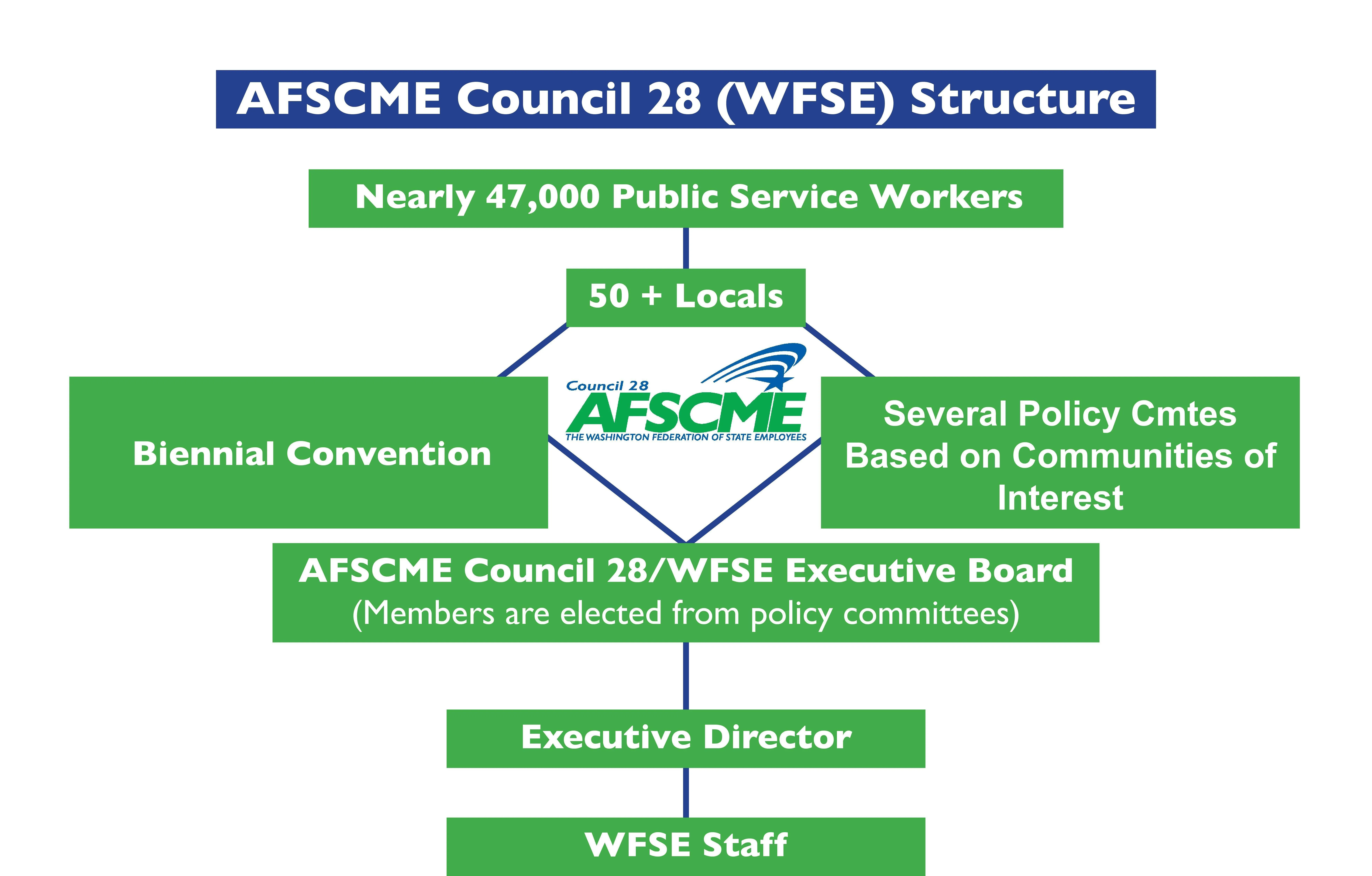Structure of WFSE
So, what is WFSE anyway? And how is it different from AFSCME Council 28? Which one is our union? We've provided a "basic" outline below. If all of this gives you a headache, see our Get Involved! page instead to learn many of the ways people participate in WFSE.

WFSE stands for the Washington Federation of State Employees. It is another name for AFSCME Council 28. AFSCME, the parent organization, is the American Federation of State, County, and Municipal Employees, which represents public servants across the country. Further, AFSCME is an affiliate of the AFL-CIO (American Federation of Labor and Congress of Industrial Organizations), one of the largest and most well-known labor federations in the United States.
Well, if really we're just part of WFSE, which is part of AFSCME, which is part of the AFL-CIO, they're really the ones making decisions, right? Not quite.
While the AFL-CIO and AFSCME provide some structure and do have some requirements, much of what they do is provide additional weight and influence to the voices of working people at the national level. They don't determine the laws and policies we fight for or against in Washington State, they don't tell us which workers most need a raise, and they don't usually direct us on how to fix the problems that we encounter every day.
If the most significant decisions don't come down from the top, then who makes them? They come from our members and work their way up. This is what makes involvement in union meetings and activities, completing surveys, and submitting bargaining proposals so important - they tell union leaders what problems we are having, how we want them to be fixed, and what we want them to be doing.
Every union member in DCYF is part of a local, a regional group of WFSE members that works to address issues and take action on what its members find important. Locals are numbered (Local 889, Local 1221, etc.) and may include members from different agencies or organizations in addition to DCYF employees. Locals elect members to a variety of internal positions, including officers and executive board members. Larger locals may have committees to work on different issues or areas of focus. They also elect members to represent their locals and other members in WFSE's Biennial Convention, AFSCME's International Convention, and WFSE's 12 statewide policy committees.
Policy committees address issues relevant to their members and send resolutions for larger actions to the statewide executive board. DCYF's Policy Committee focuses on issues that impact DCYF Child Welfare and Licensing Division employees. Our policy committee created a petition for a support staff pay increase that was eventually adapted into a statewide campaign. We have also endorsed bargaining proposals, coordinated statewide actions, and provided a forum for locals to communicate with each other. Policy committees elect representatives to the WFSE Executive Board, of which there is only one.
The 12 policy committees are:
- Corrections
- Employment Security
- Department of Children, Youth and Families
- Higher Education
- Human Services
- Institutions
- Labor and Industries
- Legal Services
- Natural Resources
- Public Service
- Transportation
- Unified State Agencies
The WFSE Executive Board is the body charged with carrying forward the resolutions approved at WFSE's Biennial Convention, and conducting the business of the membership between conventions. They receive requests for action (resolutions) from the policy committees, and coordinate our actions across agencies and organizations. There are also committees (not policy committees) of the Executive Board, including Organizing Committee, Legislative and Political Action Committee, and Strike Committee.
WFSE's Biennial Convention, held in odd-numbered years, is where officers are elected for WFSE's Executive Board. Policies for the next two years are also created, and the WFSE constitution can be amended.
During even-numbered, the AFSCME International Convention takes place. This is similar to WFSE's Biennial Convention, but for AFSCME overall.
This is not a complete explanation of everything, but our intent is to cover the basics so that our members have a better understanding of how WFSE works. If you have a question that isn't answered here, please contact us at [email protected]!
